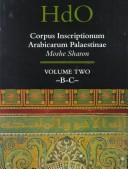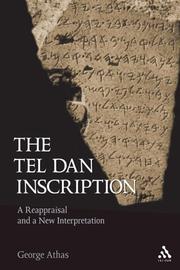| Listing 1 - 3 of 3 |
Sort by
|

ISSN: 01699423 ISBN: 9004110062 9004108335 9789004250970 9789004254817 9004110836 9004131973 9789004157804 9789004170858 9789004142893 9789004108332 9789004110830 9789004131972 9789004324794 9789004325159 9004254811 9004250972 9004325158 9004324798 9789004440135 9789004470033 9789004470040 9786610859375 904740467X 1280859377 1433703726 1306318890 9004470034 9004470042 9789047424161 9789004110069 9004157808 9004170855 9047424166 9789004440562 9789047404675 Year: 2017 Volume: 30 Publisher: Leiden
Abstract | Keywords | Export | Availability | Bookmark
 Loading...
Loading...Choose an application
- Reference Manager
- EndNote
- RefWorks (Direct export to RefWorks)
Western Palestine is extremely rich in Arabic inscriptions, whose dates range from as early as CE 150 until modern times. Most of the inscriptions date from the Islamic period, for under Islam the country gained particular religious and strategic importance, even though it made up only part of the larger province of Syria. This historical importance is clearly reflected in the hundreds of inscriptions, the texts of which cover a variety of topics: construction, dedication, religious endowments, epitaphs, Qur'anic texts, prayers and invocations, all now assembled in the Corpus Inscriptionum Arabicarum Palaestinae ( CIAP ). The CIAP follows the method established at the end of the 19th century by Max van Berchem, namely, the studying of the Arabic inscriptions 'in context'. Van Berchem managed to publish two volumes of the inscriptions from Jerusalem: the CIAP covers the entire country. The inscriptions are arranged according to site, and are studied in their respective topographical, historical and cultural context. In this way the CIAP offers more than a survey of inscriptions: it represents the epigraphical angle of the geographical history of the Holy Land. Volume One: (A) was published in 1997, Volume Two: (B-C) in 1999, Volume Three: (D-F) in 2004, Volume Four: (G) in 2008, an Addendum in 2007, Volume Five: (H-I) in 2013, Volume Six: J (1) in 2016 and Volume Seven: J (2) Jerusalem 1 in 2021. All volumes are still available.
Inscriptions, Arabic
---
Inscriptions arabes
---
Epitaphs
---
Inscriptions islamiques
---
Épigraphie
---
930.271 =927
---
930.271 <33>
---
-Inscriptions, Arabic
---
-492.7
---
Arabic inscriptions
---
Biography
---
Inscriptions
---
Tombs
---
Epigrafie--=taal--Arabisch
---
Epigrafie--

ISBN: 0826460569 0567040437 9780567322821 0567322823 9780826460561 1281803073 9786611803070 9780567040435 Year: 2003 Volume: 360 12 Publisher: London New York Sheffield Academic Press
Abstract | Keywords | Export | Availability | Bookmark
 Loading...
Loading...Choose an application
- Reference Manager
- EndNote
- RefWorks (Direct export to RefWorks)
The first book-length treatment of the most important, and controversial, inscription found in Israel in recent years. The inscription contains a possible mention of the name 'David' and is thought by many scholars to verify the existence of this king. Contains a full account of the discovery, epigraphic analysis, palaeographical analysis, possible arrangement of the three fragments discovered, textual analysis and historical commentary. It is more thorough in each of these treatments than any preceding discussion, and reviews all of the major theories about the inscription, with a well-consid
222.6
---
930.271 <33>
---
Excavations (Archaeology)
---
-Inscriptions, Aramaic
---
-Aramaic inscriptions
---
Archaeological digs
---
Archaeological excavations
---
Digs (Archaeology)
---
Excavation sites (Archaeology)
---
Ruins
---
Sites, Excavation (Archaeology)
---
930.271 <33> Epigrafie--
Book
ISBN: 1589834313 9781589834316 9781589832008 1589832000 Year: 2008 Publisher: Atlanta
Abstract | Keywords | Export | Availability | Bookmark
 Loading...
Loading...Choose an application
- Reference Manager
- EndNote
- RefWorks (Direct export to RefWorks)
Monasticism and religious orders --- Monachism --- Monastic orders --- Monasticism and religious orders for men --- Monasticism and religious orders of men --- Orders, Monastic --- Orders, Religious --- Religious orders --- Brotherhoods --- Christian communities --- Brothers (Religious) --- Friars --- Monks --- Superiors, Religious --- History --- Petre, --- Theodosius, --- Romanus, --- Romain, --- Ῥωμανός, --- Rhōmanos, --- Théodose, --- Peter, --- Petr, --- Petrus, --- Petrus Iberus, --- Pierre, --- 271 <33> --- 276 =923 --- Kloosterwezen. Religieuze orden en congregaties. Monachisme--Oud-Palestina. Judea --- Syrische patrologie
| Listing 1 - 3 of 3 |
Sort by
|

 Search
Search Feedback
Feedback About UniCat
About UniCat  Help
Help News
News